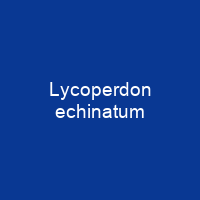Lycoperdon echinatum: The Spiny Puffball
Imagine a world where mushrooms are not just silent observers but active participants in nature’s grand theater. One such actor is Lycoperdon echinatum, the spiny puffball, a fascinating character that has been playing its part for centuries.
The Family and Habitat of Lycoperdon echinatum
Found in diverse habitats across continents—Africa, Europe, Central America, and North America—this mushroom thrives on soil in deciduous woods, glades, and pastures. It’s like a nomad, adapting to different environments while maintaining its unique identity.
The Appearance of Lycoperdon echinatum
When you first encounter Lycoperdon echinatum, it might remind you of a tiny, spiky ball. Initially white and spherical or pear-shaped, these puffballs grow to be 2-4 cm wide before their spines start to fall off, leaving behind a net-like pattern of scars. As they mature, the exterior turns dark brown, much like a seasoned traveler’s face after years in the sun.
History and Classification
The species was first described by Christian Hendrik Persoon way back in 1797. Over time, it was reduced to a variety but later raised again to its current status as a distinct species due to its unique characteristics. Molecular analysis has shown that Lycoperdon echinatum is closely related to the puffball genus Handkea, much like distant cousins sharing a common ancestor.
Edibility and Health Benefits
When young, these puffballs are edible with a firm texture and white interior. They’re not just tasty but also have potential health benefits. Laboratory tests have shown that extracts from Lycoperdon echinatum can inhibit the growth of several bacteria harmful to humans. It’s like having a natural antibiotic in your backyard, ready for the picking.
The Life Cycle and Threats
Lycoperdon echinatum grows on the ground in deciduous forests, grassy areas, and pastures, often in beech woods. Its fruit bodies appear anytime from late spring to autumn, but older specimens are more likely to be overlooked due to their brown color. It’s a bit like finding an old friend who has changed with time.
Despite its adaptability, Lycoperdon echinatum faces threats such as soil acidification, making it a threatened species in some areas. This highlights the importance of preserving these natural habitats to ensure that our mushroom friends can continue their roles in nature’s drama.
Conclusion: The Spiny Puffball’s Role in Nature
The spiny puffball, Lycoperdon echinatum, is more than just a pretty face. It’s a resilient actor that plays its part in the grand stage of nature, adapting to different environments and providing us with both culinary delights and potential health benefits. As we continue to explore and understand these fascinating fungi, let us also remember their importance in maintaining the delicate balance of our ecosystems.

You want to know more about Lycoperdon echinatum?
This page is based on the article Lycoperdon echinatum published in Wikipedia (retrieved on November 27, 2024) and was automatically summarized using artificial intelligence.







